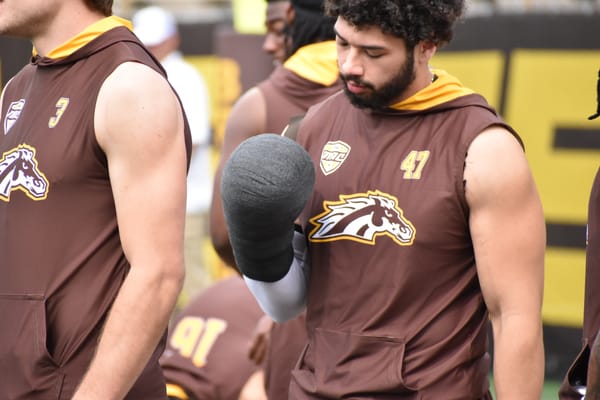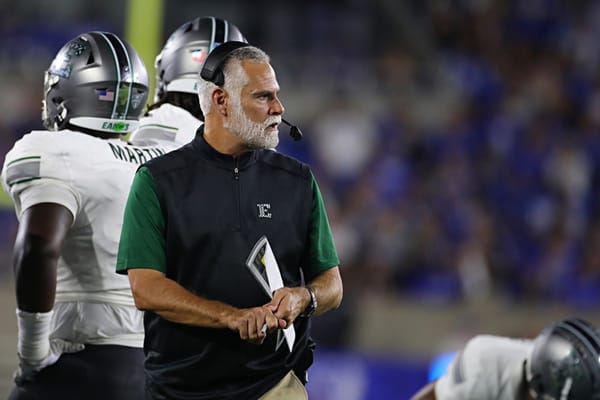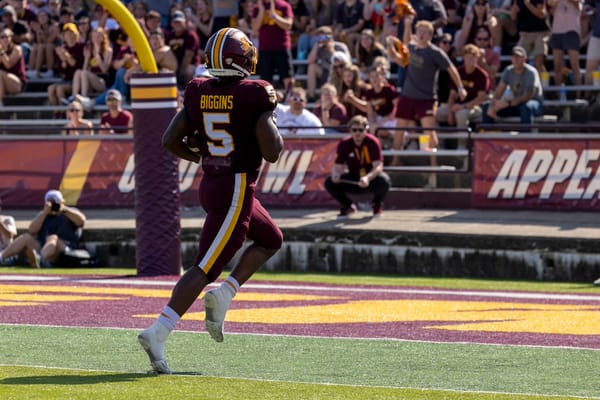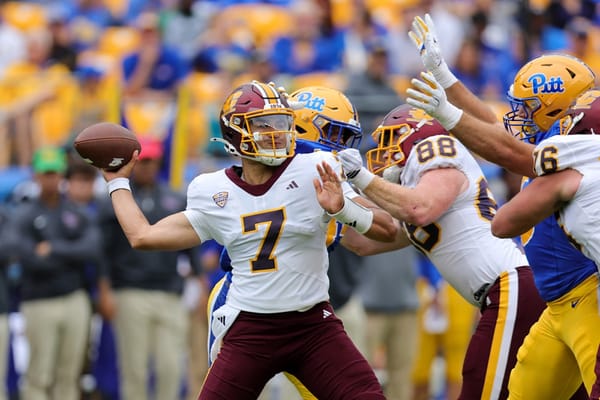Week off check in: How Michigan, Michigan State shape up after 4 weeks
Both the Big Ten teams in the Mitten are off this week, a good chance to check in with how things have gone through four weeks of the season.
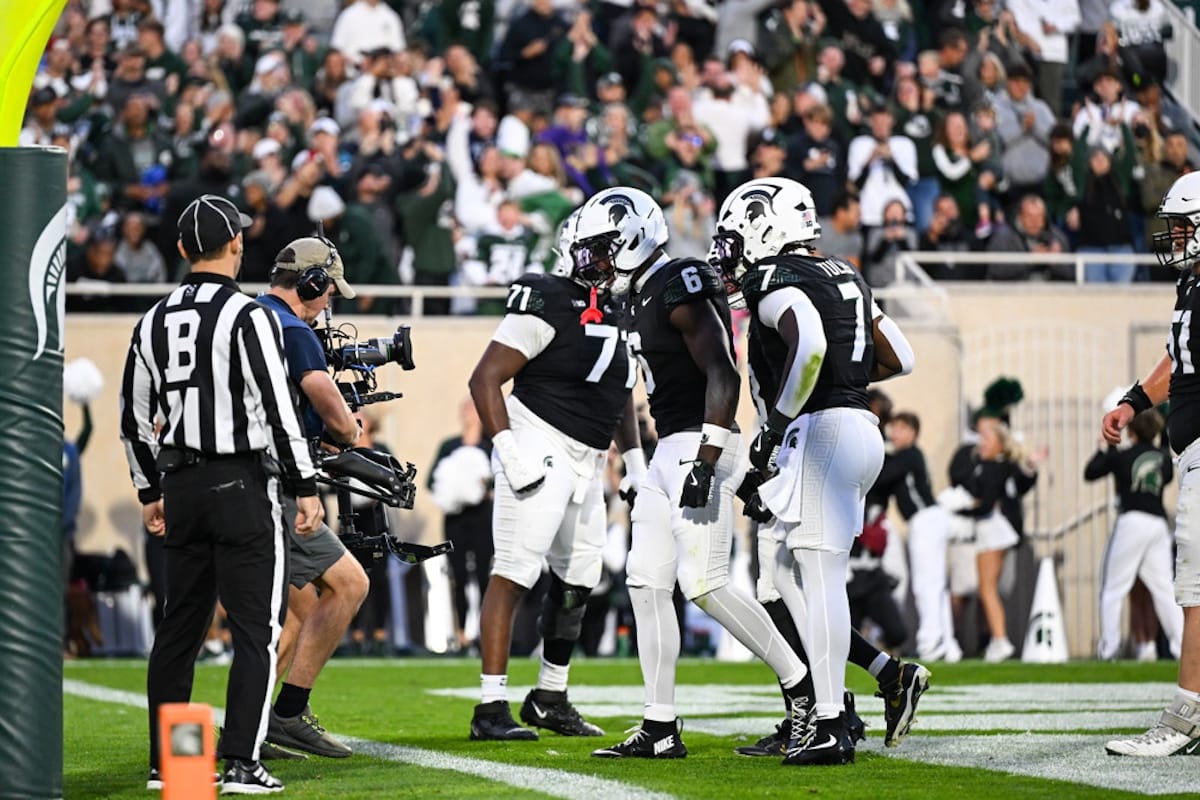
The two Big Ten teams in the Mitten are idle this week, resting up before a trip to Nebraska for Michigan State and a visit from Wisconsin for Michigan.
So after four weeks of games, at the one third mark of the regular season — or the quarter point of the whole season, if you ask Michigan head coach Sherrone Moore — it’s a good chance to assess where both these teams stand as conference play gets real in the coming months.
“Treating it like we just ended the first quarter of the season,” Moore said on Monday. “Four games, then you've got a bye. Four games, then you got another bye. Four games, and then you have the postseason. So that was the first quarter. We're going into the second quarter, and we're going to go attack it.
On the surface, things have gone about as expected for both teams. Both squads are 3-1 and lost on the road against a Top 25 opponent. Michigan experienced a slow death in a 24-13 loss at Oklahoma and Michigan State just got outraced by USC in the Coliseum.
But scratching under the surface, both teams have some big things to build on, and fix, with the season through four weeks.
We’ll start with the Spartans.
Michigan State
The good
Aidan Chiles: Nothing has been, or will be more important to the success of Michigan State this season than the play of quarterback Aidan Chiles. And so far, so good.
He wasn’t stellar against USC and is working on an evolved balance between his role as a passer and ability as a runner, but Chiles has driven the Michigan State offense while cutting back on the punishing mistakes that cost him a year ago.
In four games, he’s completed 68.6% of his passes for 868 yards and nine touchdowns with one interception. And that interception came on a throw batted in the backfield, for what it’s worth. As a runner, Chiles has remained an effective and dangerous threat, carrying 39 times for 154 net yards (he has been sacked 10 times, one of the worst figures in college football, for 71 yards lost) and two touchdowns.
The upside on Chiles has never been a secret, and the third-year QB is looking like he’s starting to reach his immense potential, albeit in flashes, this season for the Spartans.
Run defense: Michigan State’s run defense has been solid to start the year, and that’s a testament to the increased depth and talent on the defensive line and a deep, experienced linebacking corps.
The Spartans are in the Top 50 nationally in rushing success rate allowed, rank No. 51 in the country in rush yards allowed per game (120.5 per game) and until playing USC and getting a bit overmatched, Michigan State had surrendered two rushing touchdowns in three games. It’s not five in four games after the Trojans punched in three scores on the ground.
It’s not an outright smothering unit, and it hasn’t produced many negative plays for the opponent, but the Spartans run defense unit is hard to move the ball on. Keeping that up will serve the Spartans well in conference play going forward.
The Solid-In-Need-Of-Slight-Improvement
Run game: Michigan State’s rushing offense has been improved from 2024, but it still isn’t an explosive or threatening ground attack for the Spartans, even if the efficiency has begun to show up.
The sophomore back duo of Makhi Frazier and Brandon Tullis have been a solid 1-2 punch out of the backfield, especially with Chiles adding value as a scrambler and occasional designed runner. Frazier is averaging 4.7 yards per carry and has 267 yards and two touchdowns in four games, while Tullis is going for 5.1 yards per carry for 128 yards and two touchdowns.
And a lot of the credit for the improvements in the run game stem from improvements on the offensive line, where a number of transfers and returning starters have meshed together to form what’s been, so far, an improved run blocking unit. There’s still plenty of room for that group to grow, though, especially in cleaning up penalties and the occasional missed assignment. And getting healthier in a few spots out of a week off would help, too.
Fewer turnovers, more takeaways: To be clear, turning the ball over hasn’t been a pronounced problem for Michigan State. But when the defense isn’t taking away the ball much either, even a small number of turnovers can quickly be problematic.
Through four games, the Michigan State turnover margin is at 0, exactly as many takeaways as giveaways. The most costly single takeaway for Michigan State this year, a pick six in Week 1 thrown by backup QB Alessio Milivojevic, didn’t matter in the grand scheme of the season, and Chiles has protected the ball outside of his lone pick, generally. But Michigan State has fumbled five times and lost two. The Spartans might not be as lucky in future weeks.
Which means there’s even more onus on the defense to come up with some takeaways. Safety Armorion Smith has accounted for two of the four for MSU’s defense this year, with a key pick against Youngstown State and a critical fumble forced against USC to help the Spartans make it a one-score game in the third quarter.
It’s evident how much Michigan State can benefit from winning the turnover battle, something it hasn’t done in total through four games.
The Stuff That Needs To Show Up
Pass defense: Michigan State’s pass defense entered Saturday night suspect and left indicted, with a chance to get convicted for being bad against Dylan Raiola and Nebraska this upcoming Saturday. The Spartans simply need to be better defending the pass.
USC is arguably the best passing offense in the country, and one of the most productive so far by a lot of metrics. And the Spartans did little to induce so much as a hiccup from it on Saturday night. And that’s after struggling in back-to-back weeks against Boston College and Youngstown State. The only team MSU has handled well in the pass game was Western Michigan, one of the worst statistical passing teams through four games.
The Spartans are allowing a 67.6% completion rate against the defense, 18th to last in the FBS. And next up is Raiola, a quarterback completing 75.6% of his passes, ranking No. 3 nationally.
Defensive coordinator Joe Rossi stressed consistency constantly in his press conference before facing USC, and the defense will need to find something consistent in pass defense to stem the tide.
Pass rush: Part of the reason MSU can’t get much done on the backend is an inability to disrupt opposing passing games in the backfield. Michigan State has six sacks through four games, in the bottom third of college football.
Four of the six sacks came in the opener against Western Michigan, two came against Youngstown State and the Spartans have no sacks in two games against Power 4 opponents. And that’s not a reality that can hold for Michigan State’s defense to be successful in the final eight games of the season.
Rossi and the defense prioritized pass rush and backfield disruption in fall camp and so far it hasn’t materialized. On top of the paltry sack figures, Michigan State has 22 tackles for loss, but managed none against USC and 18 of those came in the two games against Western Michigan and Youngstown State.
Be it individuals stepping up or scheme creating wins via stunts, blitzes and simulated pressures, Michigan State’s defense needs to better affect the passer and make plays in the backfield the rest of the season.
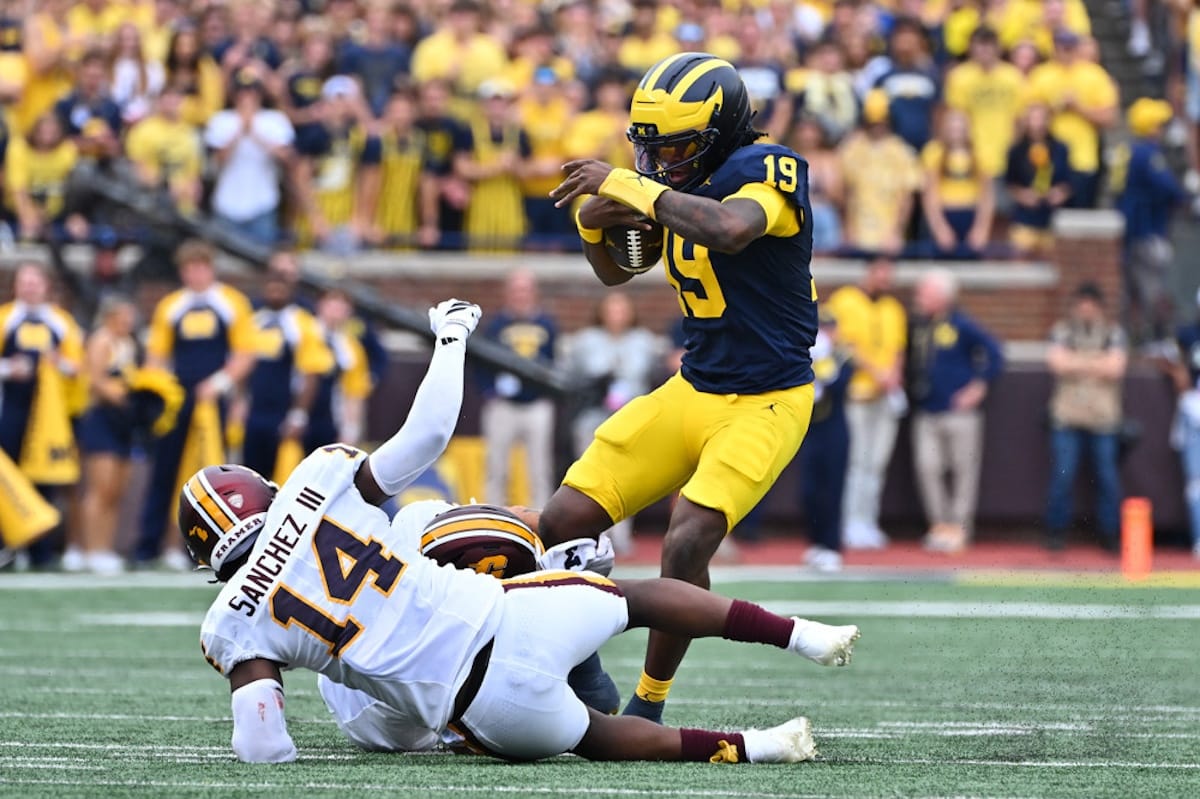
Michigan
The Good
Justice Haynes, Jordan Marshall and the run game: Michigan is one of nine teams in college football to cross the 1000 yard rushing threshold as a team through four games.
Much of the rushing production has come from Haynes, as the Alabama transfer has gone for more than 100 yards and a touchdown in each of his first four games for Michigan, something no Wolverine back has done to open their career. And Marshall has come on of late, with his strongest performance of the season coming against Nebraska. The added factor of Bryce Underwood’s running has juiced up the rushing game for Michigan too.
And the biggest difference between this Michigan running game and that of years past is the pure explosion of it. Haynes again is central to that, with multiple 75-yard touchdown runs this season and a number of other big hitters. Marshall ran in a 54-yard touchdown against Nebraska, too, while Underwood scored from 37 yards on a keeper.
Michigan’s offensive line, which has played with a pair of backup guards the past two weeks, has also started to look like the sort of rugged unit that Moore has been known to produce.
Altogether, being efficient and explosive on the ground is a great way to live as an offense.
Defensive front seven disruption: Michigan has 14 sacks in four games, tied for No. 8 nationally. And the pressure and disruption is coming from all over the box.
And Michigan’s two leading sack getters through four games are both linebackers, as Jaishawn Barham has three and Cole Sullivan has a pair. Barham has spent some time lined up rushing off the edge, and has looked dangerous doing so. Ernest Hausmann also has a sack and cornerback Jyaire Hill picked up one on a corner blitz against Central Michigan.
A deep defensive line group has shown up, too, with Derrick Moore, Rayshaun Benny, Cameron Brandt, Enow Etta and Dominic Nichols all have gotten in on sacks.
Michigan also has 32 tackles for loss on the season. It’s a deep, versatile and disruptive group up front for Wink Martindale, and it’s looking the part so far.
The Solid-In-Need-Of-Slight-Improvement
Pass defense: Michigan hasn’t been bad, per se, against the pass in 2025, but the group hasn’t been locking down opponents, either.
The Michigan secondary is relatively young, mixing a handful of players with notable experience with some much younger pieces, and transfers like TJ Metcalf. Getting Rod Moore back in the mix should help at safety as he provides some soundness next to the hard-hitting Brandyn Hillman.
An injury to Zeke Berry has tested the cornerback and nickel depth, though true freshman Jayden Sanders has stepped in on the outside and earned lots of praise after his recent performances. Late against Central Michigan, the Wolverines actually had four freshman playing in the secondary, as the likes of Shamari Earls and Elijah Dotson — who got an interception against the Chippewas — got some run.
In general, the pieces are there for the Michigan pass defense to improve and evolve into a shutdown group. But right now, the new combinations of players on the backend are still ironing out some wrinkles.
Offensive passing polish: Underwood, through four games, has performed well for a freshman quarterback making his first four career starts. He’s looked like a freshman at times, and he’s looked like a freshman who was the No. 1 recruit in the 2025 class at others.
He’s already an upgrade on Michigan’s ability at the position last year, particularly with his playmaking and ability to throw. But there’s also lots of space for Underwood to ascend from an über-talented true freshman to fulfilling the immense promise of his talents and physical ability, and a lot of that will be the finer elements of passing.
And that will likely come as he takes more reps and feels the timing and spacing of college football better, and banks reps to develop a bit more touch and layering on his throws. More time on task with the receivers, who had some tough drops against Nebraska, will help.
It’s been a good start for the Michigan passing offense, but there’s definitely been yards and plays left out there, plays that can be made as the passing operation gets, ideally, to “well-oiled machine” status.
The Stuff That Needs To Show Up
Taking the passing game on the road: The splits between Michigan’s two home games and two road games are stark, as far as the passing offense is concerned.
At home, Underwood is 37-of-56 (66.1%) for 486 yards and two touchdowns with one interception.
On the road, Underwood is 21-of-47 (44.7%) for 247 yards.
Some of the disparity is due to Michigan’s conservative offensive gameplan at Oklahoma, but the offense aired it out some more against Nebraska and Underwood actually had fewer passing yards. Some of that is on the receivers, too, but the whole operation has been minimally productive outside of Michigan Stadium.
It largely hasn’t been a problem so far, with Michigan’s rushing attack working well, and the two road games have been Power 4 competition as opposed to two easier opponents at home. But the rest of the games will be Power 4 competition, and Michigan will surely need the passing game to show up somewhere down the line on the road.
Penalties: Michigan isn’t that penalized relative to the rest of the country, but this is more about the nature and timing of the penalties. Look no further than Hillman’s taunting penalty — which has been roundly criticized and memed — at the Nebraska sideline that turned a 4th and long into a 1st and 10, and eventually a Cornhuskers score.
Against Central Michigan, a pair of long touchdown runs got taken off the board due to holding penalties down the field.
None of this has torpedoed the Wolverines, yet, but in a sport where “controlling what you can control” is gospel, not committing costly errors, often unforced, feels like an easy way to improve.
